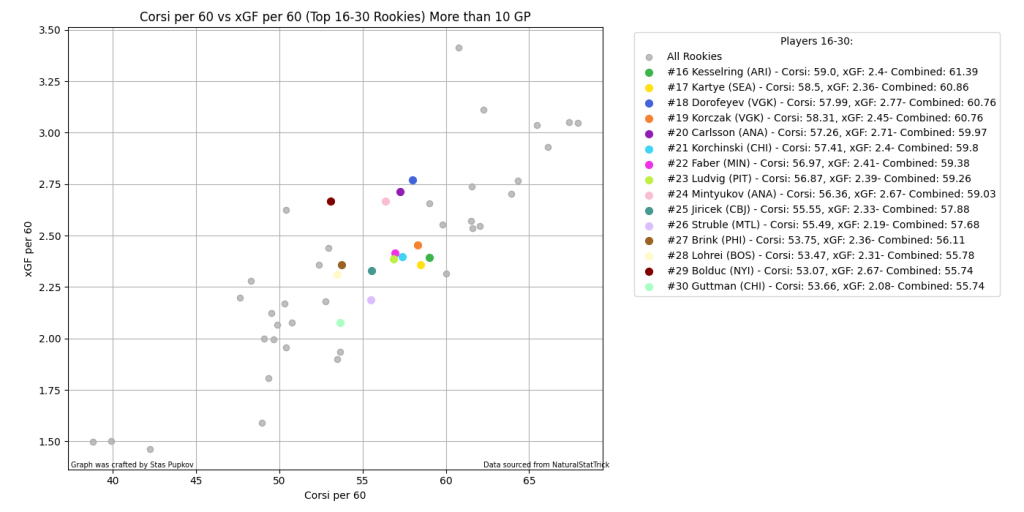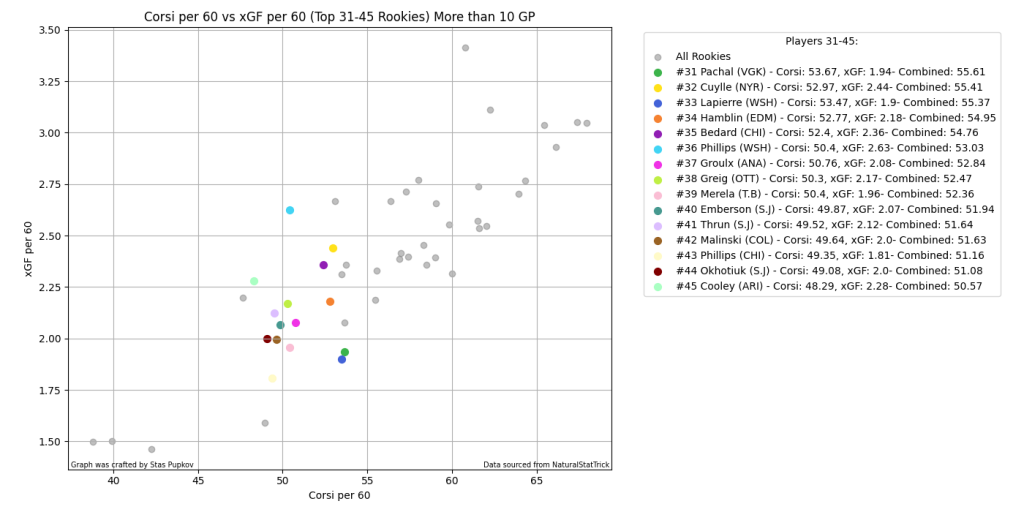The NHL’s landscape is continually reshaped by the influx of rookie talent, each bringing a fresh wave of skill and potential to the ice. In the realm of fantasy hockey, understanding these emerging stars is crucial. This analysis dives into the heart of rookie performance, leveraging advanced metrics – Corsi per 60 and expected goals for (xGF) per 60 – to peel back the layers of raw talent and strategic play. By employing these metrics, which offer a deeper insight than traditional statistics, we can uncover the real impact these rookies have on the game. From their ability to control the puck to creating scoring opportunities, this study aims to highlight the rookies who are not just playing the game but redefining it.
Understanding the Metrics
In hockey analytics, Corsi per 60 and xGF per 60 are pivotal in understanding a player’s impact on the game, especially when assessing new talent like NHL rookies. These advanced metrics offer a nuanced perspective that goes beyond goals and assists.
Corsi per 60 focuses on shot attempt differential while a player is on the ice. It accounts for shots on goal, missed shots, and blocked shots, providing a broader view of a player’s offensive engagement and puck possession skills. By normalizing this to a 60-minute timeframe, we can compare players fairly, irrespective of their ice time differences. A higher Corsi per 60 indicates more frequent shot attempts, suggesting offensive dominance and effective puck control.
xGF per 60 takes this analysis further by assessing the quality of these shot attempts. It uses factors like shot location, angle, and type to estimate the likelihood of each shot becoming a goal. This metric helps in understanding not just how often a player shoots, but also how likely those shots are to score. High xGF per 60 players are often those who consistently find themselves in prime scoring positions or have the skill to create high-quality shots.
By combining Corsi per 60 and xGF per 60, we gain a comprehensive understanding of a rookie’s offensive contributions. While Corsi per 60 shows us their ability to drive play and maintain offensive pressure, xGF per 60 reveals their knack for creating genuine scoring chances. Together, these metrics offer a potent tool to unearth the true value rookies bring to the ice, beyond what traditional stats might reveal.
Data and Methodology
This analysis delves into NHL rookies’ performance using advanced metrics, sourced from NaturalStatTrick. By focusing on rookies who have played a substantial number of games, we ensure a reliable data set for assessing their impact on the ice. The key metrics, Corsi per 60 and xGF per 60, provide a dual perspective: Corsi per 60 reflects the player’s involvement in the offense, while xGF per 60 gauges the quality of their scoring opportunities. For fantasy hockey enthusiasts and analysts, this approach offers a deeper understanding of rookies’ potential and value, transcending traditional statistics to reveal insights into their true on-ice effectiveness.
Analysis and Findings
In this section, we dive deep into the heart of the data, revealing the hidden stories of NHL rookies. The analysis is segmented into three parts, each focusing on a different group of rookies based on their performance metrics:
Top 1-15 Rookies – A detailed examination of the leading rookies, showcasing those who excel in both offensive engagement and quality of scoring opportunities. This group represents the cream of the crop, rookies who are not only active in offense but also effective in creating genuine goal-scoring chances.

Top 16-30 Rookies – Here, we explore the middle tier of rookies, highlighting their unique strengths and potential areas for growth. This segment may include players who show promise in either Corsi per 60 or xGF per 60, indicating specific areas of dominance or opportunities for development.

Top 31-45 Rookies – The final group offers insights into rookies who, while not at the top of the metrics, show significant potential. This analysis could uncover hidden gems or players who might be flying under the radar but are steadily making their mark.

Each segment not only ranks these players but also provides a narrative on what these metrics tell us about their style of play, effectiveness, and potential trajectory in the NHL. This comprehensive analysis aims to offer readers an in-depth understanding of upcoming talent, making it invaluable for fantasy hockey decisions and general NHL fandom.
Analyzing the Underlying Value: Brock Faber’s Season Review
In our graphical analysis, Brock Faber ranks at #22, a position primarily influenced by offensive metrics like Corsi per 60 and xGF per 60. However, these rankings discredit the incredible season he’s having with the Minnesota Wild in 23/24. Faber’s true value is illuminated when delving deeper into his overall performance:
Defensive Mastery – With a remarkable 61 shots blocked, Faber stands as a defensive bulwark. His ability to disrupt opposing offenses is a critical component of the Wild’s defensive scheme.
Physicality and Presence: His tally of 46 hits reflects an assertive physical presence on the ice, crucial in dictating the pace and flow of the game.
Contributing on Offense – Despite being a defenseman, Faber’s 16 points, including 2 goals, show his capability to contribute meaningfully to the team’s offensive efforts.
Disciplined Play – A low penalty count not only speaks to Faber’s discipline but also to his strategic understanding of the game, ensuring he remains a key player for the team without putting them at a disadvantage.
Ranking at #22 in our analysis based on specific metrics, Faber’s season tells a story of a player whose impact transcends what is often captured in traditional offensive statistics. His all-around performance makes him a standout player, illustrating the importance of looking beyond conventional metrics to appreciate a player’s true contribution to their team.
Implications and Insights
The analysis of NHL rookies using Corsi per 60 and xGF per 60 metrics, coupled with case studies like Brock Faber, offers several critical implications and insights:
Comprehensive Player Evaluation – The case of Brock Faber underscores the importance of a holistic approach to player evaluation. While Corsi per 60 and xGF per 60 are invaluable in assessing offensive capabilities, they represent only part of a player’s overall impact.
Strategic Team Building – For team management and coaches, understanding the multifaceted nature of player contributions is key to building a balanced and effective team. Players like Faber, who excel in non-scoring aspects, can be just as crucial to a team’s success as top scorers.
Fantasy Hockey Strategy – Fantasy league enthusiasts should consider a broad spectrum of metrics when selecting players. While scorers often grab the headlines, players who excel in defensive metrics can provide a competitive edge.
Emerging Trends and Talent Identification – The analysis highlights emerging trends in rookie performances and can aid in identifying rising stars in the NHL. It offers a glimpse into the future of hockey, showcasing the players who might soon dominate the league.
Public Perception and Recognition – This study also speaks to the need for greater recognition of players who contribute in less quantifiable but equally important ways. It challenges fans and analysts to appreciate the diverse skills that players bring to the ice.
In conclusion, while metrics like Corsi per 60 and xGF per 60 offer valuable insights, they are just pieces of the puzzle. A complete player assessment requires considering various aspects, from scoring and assisting to defensive play and on-ice decision-making. This nuanced approach to analysis enriches our understanding of the game and the players who make it exciting.
Twitter/X – @DH_staspup for any questions, corrections, or comments
Thank you for reading and have a great rest of your day!





 SEA
SEA NYI
NYI BUF
BUF DAL
DAL CBJ
CBJ NYR
NYR ANA
ANA STL
STL L.A
L.A
